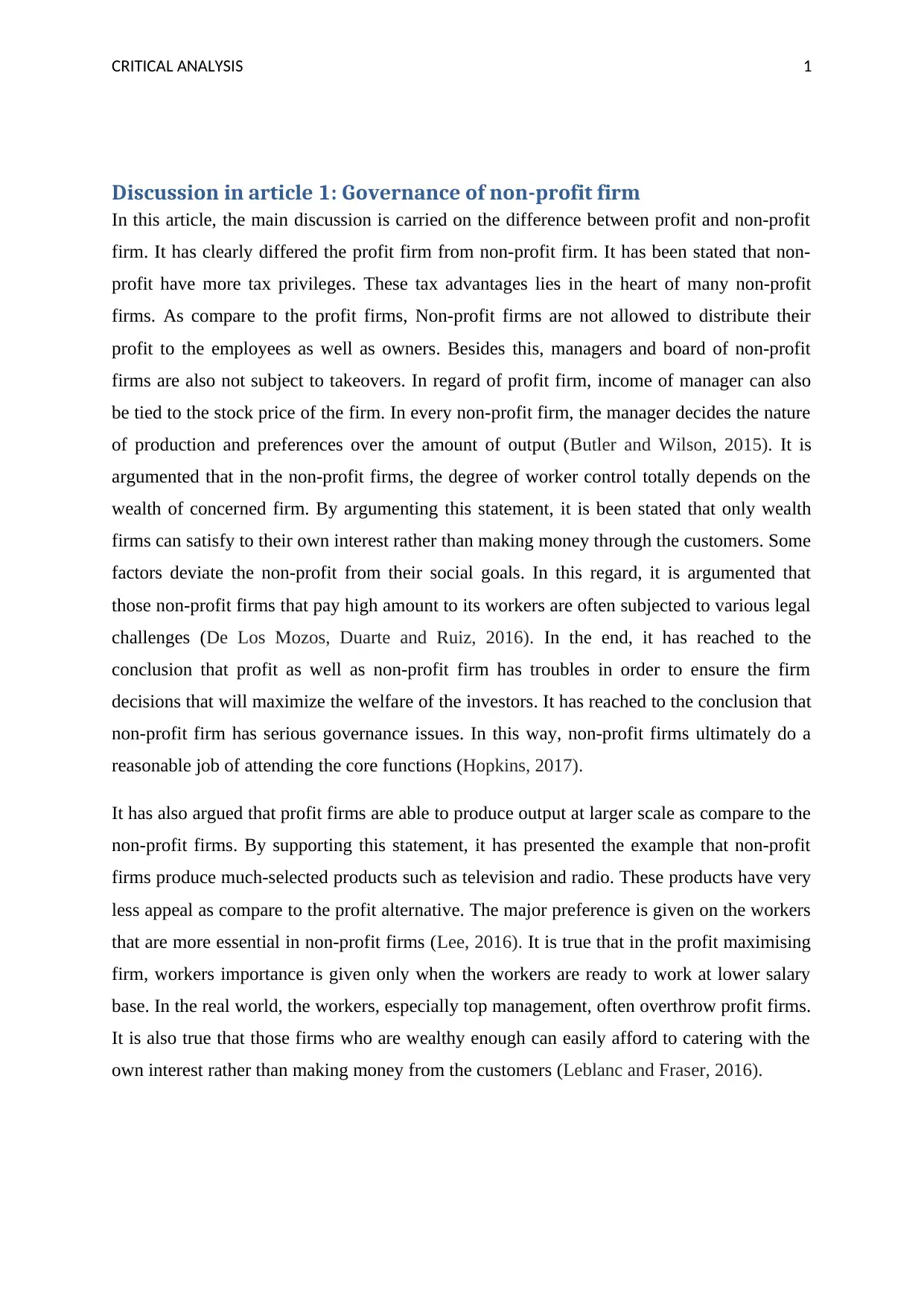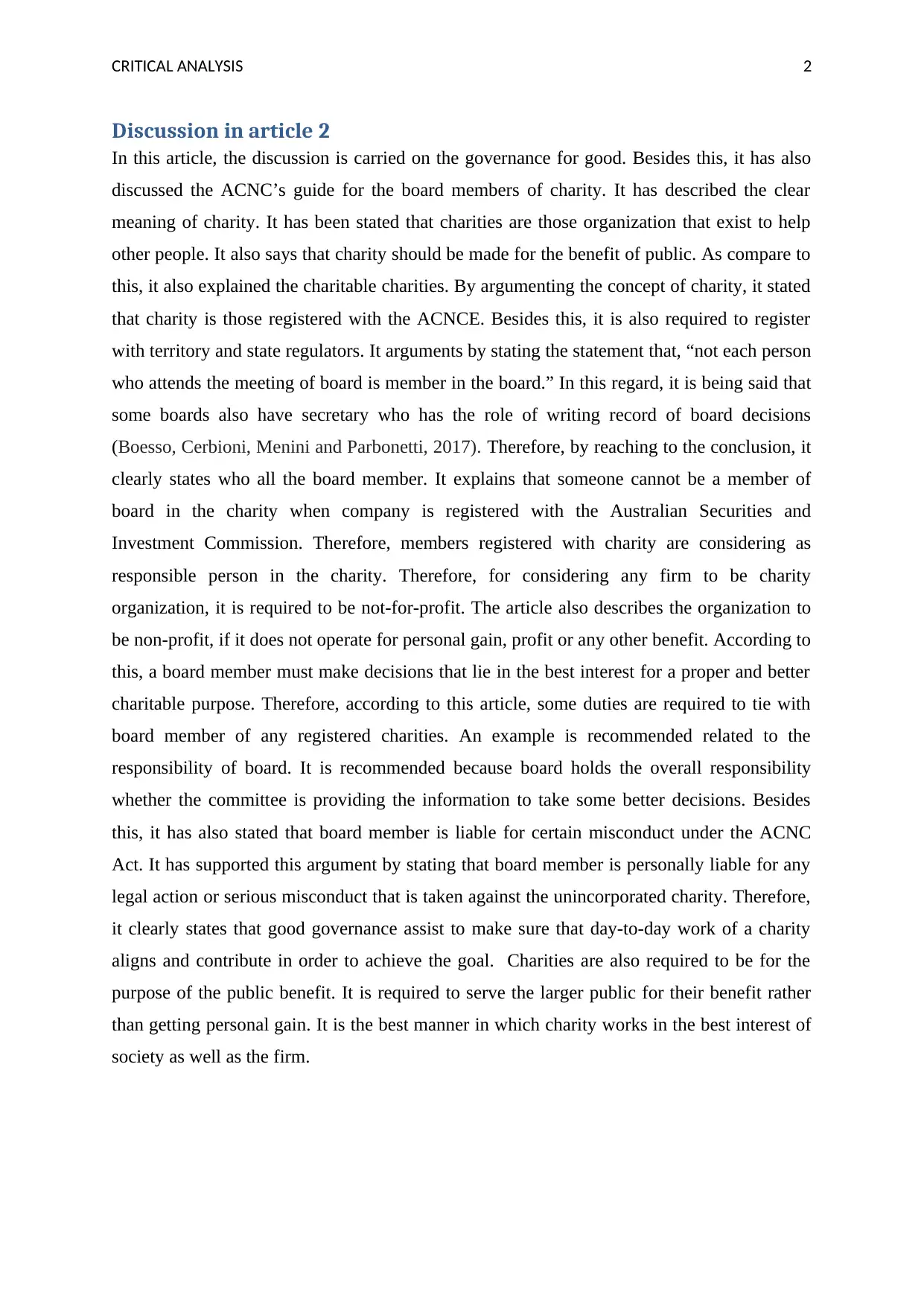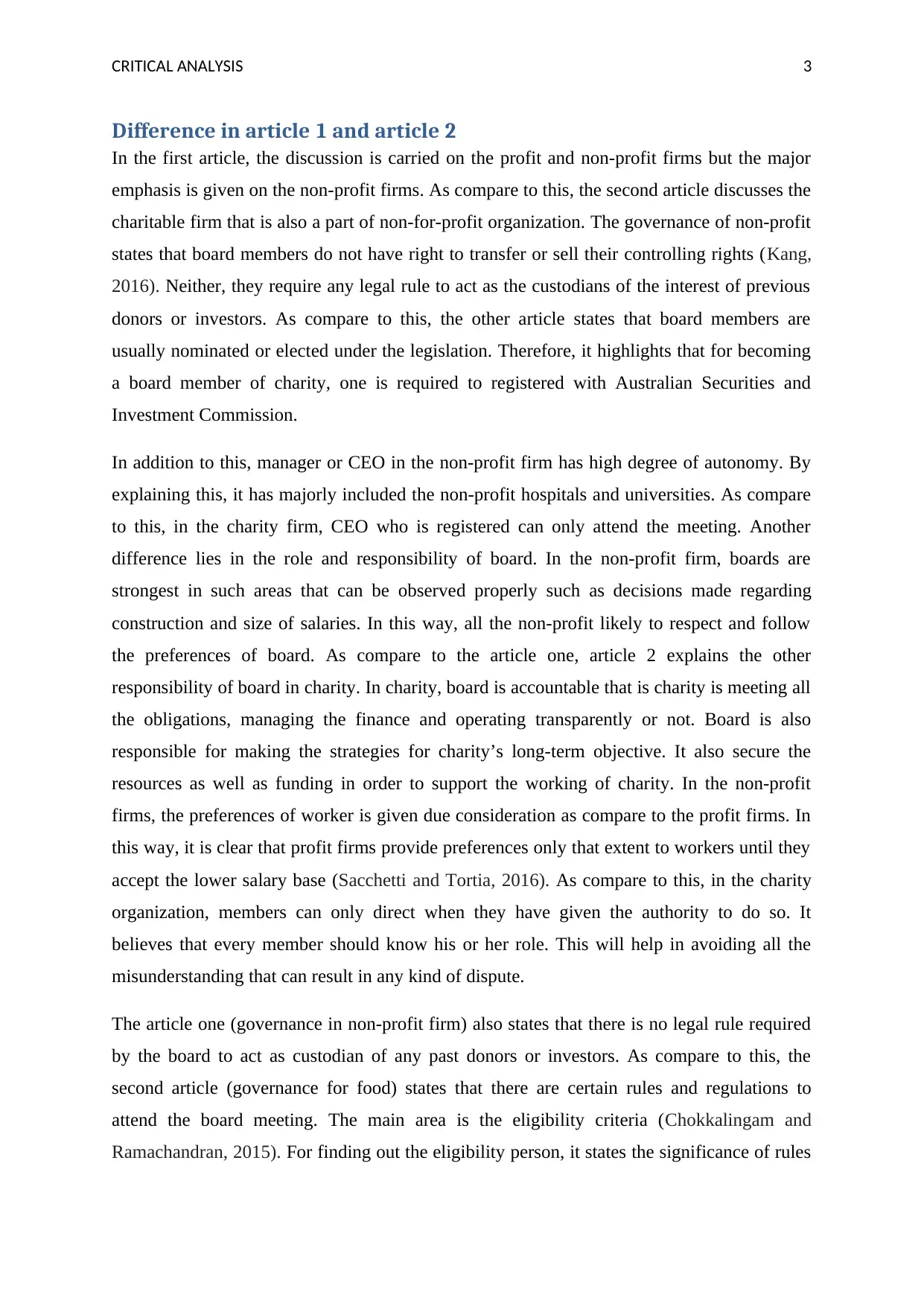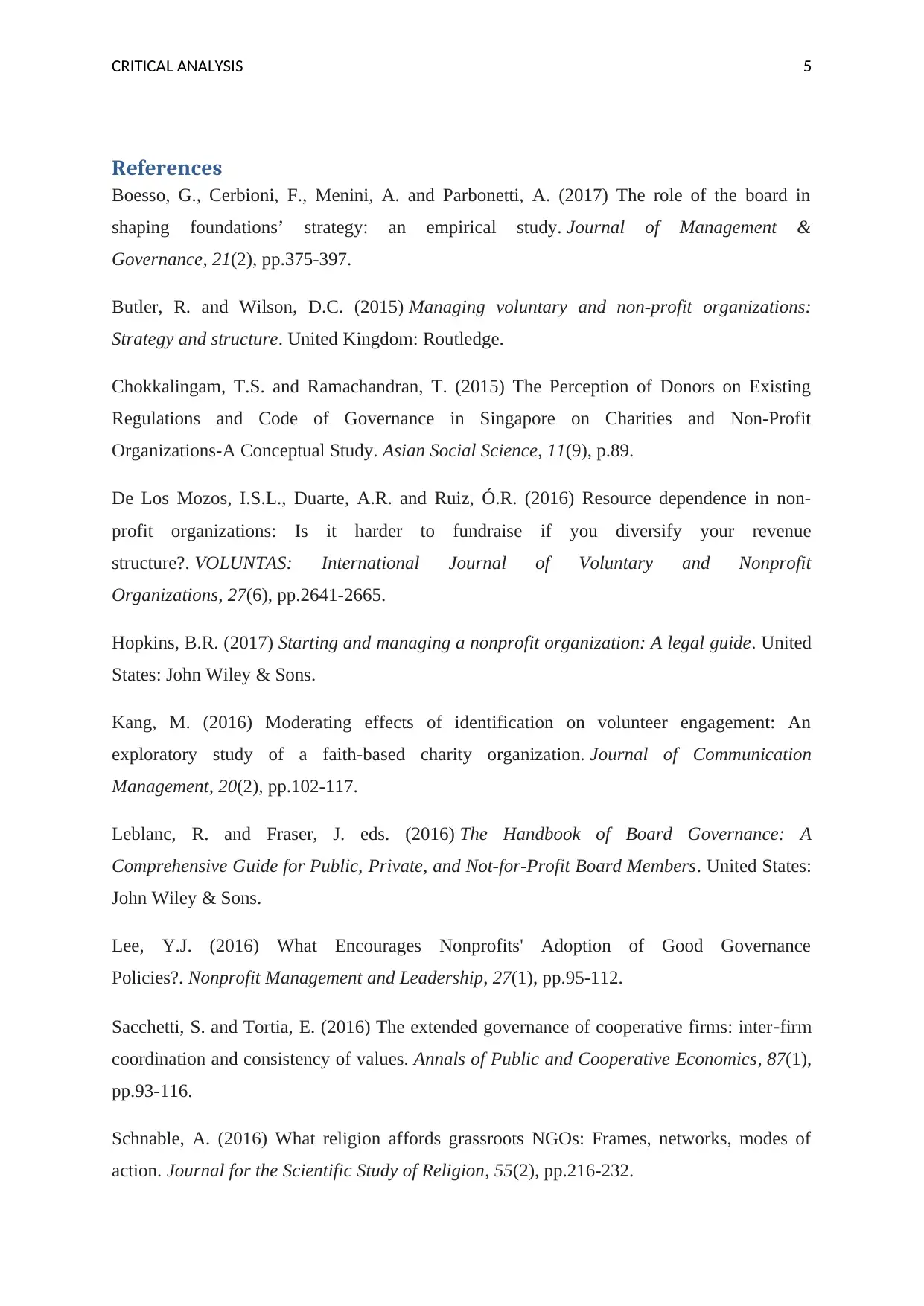Critical Analysis: Governance of Non-Profit and Charitable Firms
VerifiedAdded on 2023/04/22
|7
|2087
|246
Essay
AI Summary
This essay presents a critical analysis of the governance structures of non-profit and charitable firms, drawing on two articles. The first article discusses the differences between profit and non-profit firms, highlighting tax advantages, managerial autonomy, and the absence of shareholder-driven incentives in non-profits. It explores governance challenges, including worker control and potential conflicts of interest. The second article focuses on governance for charities, referencing the ACNC's guide for board members. It defines charities, outlines board member responsibilities, and emphasizes the importance of good governance for achieving charitable goals and serving the public benefit. The essay then compares and contrasts the two articles, examining differences in board member roles, legal requirements, and the level of autonomy granted to managers. It concludes by summarizing key distinctions in governance approaches and the emphasis on worker preferences in non-profit settings, contrasting it with profit-driven models.

Running Head: CRITICAL ANALYSIS 0
Business Communication Skills
Business Communication Skills
Paraphrase This Document
Need a fresh take? Get an instant paraphrase of this document with our AI Paraphraser

CRITICAL ANALYSIS 1
Discussion in article 1: Governance of non-profit firm
In this article, the main discussion is carried on the difference between profit and non-profit
firm. It has clearly differed the profit firm from non-profit firm. It has been stated that non-
profit have more tax privileges. These tax advantages lies in the heart of many non-profit
firms. As compare to the profit firms, Non-profit firms are not allowed to distribute their
profit to the employees as well as owners. Besides this, managers and board of non-profit
firms are also not subject to takeovers. In regard of profit firm, income of manager can also
be tied to the stock price of the firm. In every non-profit firm, the manager decides the nature
of production and preferences over the amount of output (Butler and Wilson, 2015). It is
argumented that in the non-profit firms, the degree of worker control totally depends on the
wealth of concerned firm. By argumenting this statement, it is been stated that only wealth
firms can satisfy to their own interest rather than making money through the customers. Some
factors deviate the non-profit from their social goals. In this regard, it is argumented that
those non-profit firms that pay high amount to its workers are often subjected to various legal
challenges (De Los Mozos, Duarte and Ruiz, 2016). In the end, it has reached to the
conclusion that profit as well as non-profit firm has troubles in order to ensure the firm
decisions that will maximize the welfare of the investors. It has reached to the conclusion that
non-profit firm has serious governance issues. In this way, non-profit firms ultimately do a
reasonable job of attending the core functions (Hopkins, 2017).
It has also argued that profit firms are able to produce output at larger scale as compare to the
non-profit firms. By supporting this statement, it has presented the example that non-profit
firms produce much-selected products such as television and radio. These products have very
less appeal as compare to the profit alternative. The major preference is given on the workers
that are more essential in non-profit firms (Lee, 2016). It is true that in the profit maximising
firm, workers importance is given only when the workers are ready to work at lower salary
base. In the real world, the workers, especially top management, often overthrow profit firms.
It is also true that those firms who are wealthy enough can easily afford to catering with the
own interest rather than making money from the customers (Leblanc and Fraser, 2016).
Discussion in article 1: Governance of non-profit firm
In this article, the main discussion is carried on the difference between profit and non-profit
firm. It has clearly differed the profit firm from non-profit firm. It has been stated that non-
profit have more tax privileges. These tax advantages lies in the heart of many non-profit
firms. As compare to the profit firms, Non-profit firms are not allowed to distribute their
profit to the employees as well as owners. Besides this, managers and board of non-profit
firms are also not subject to takeovers. In regard of profit firm, income of manager can also
be tied to the stock price of the firm. In every non-profit firm, the manager decides the nature
of production and preferences over the amount of output (Butler and Wilson, 2015). It is
argumented that in the non-profit firms, the degree of worker control totally depends on the
wealth of concerned firm. By argumenting this statement, it is been stated that only wealth
firms can satisfy to their own interest rather than making money through the customers. Some
factors deviate the non-profit from their social goals. In this regard, it is argumented that
those non-profit firms that pay high amount to its workers are often subjected to various legal
challenges (De Los Mozos, Duarte and Ruiz, 2016). In the end, it has reached to the
conclusion that profit as well as non-profit firm has troubles in order to ensure the firm
decisions that will maximize the welfare of the investors. It has reached to the conclusion that
non-profit firm has serious governance issues. In this way, non-profit firms ultimately do a
reasonable job of attending the core functions (Hopkins, 2017).
It has also argued that profit firms are able to produce output at larger scale as compare to the
non-profit firms. By supporting this statement, it has presented the example that non-profit
firms produce much-selected products such as television and radio. These products have very
less appeal as compare to the profit alternative. The major preference is given on the workers
that are more essential in non-profit firms (Lee, 2016). It is true that in the profit maximising
firm, workers importance is given only when the workers are ready to work at lower salary
base. In the real world, the workers, especially top management, often overthrow profit firms.
It is also true that those firms who are wealthy enough can easily afford to catering with the
own interest rather than making money from the customers (Leblanc and Fraser, 2016).

CRITICAL ANALYSIS 2
Discussion in article 2
In this article, the discussion is carried on the governance for good. Besides this, it has also
discussed the ACNC’s guide for the board members of charity. It has described the clear
meaning of charity. It has been stated that charities are those organization that exist to help
other people. It also says that charity should be made for the benefit of public. As compare to
this, it also explained the charitable charities. By argumenting the concept of charity, it stated
that charity is those registered with the ACNCE. Besides this, it is also required to register
with territory and state regulators. It arguments by stating the statement that, “not each person
who attends the meeting of board is member in the board.” In this regard, it is being said that
some boards also have secretary who has the role of writing record of board decisions
(Boesso, Cerbioni, Menini and Parbonetti, 2017). Therefore, by reaching to the conclusion, it
clearly states who all the board member. It explains that someone cannot be a member of
board in the charity when company is registered with the Australian Securities and
Investment Commission. Therefore, members registered with charity are considering as
responsible person in the charity. Therefore, for considering any firm to be charity
organization, it is required to be not-for-profit. The article also describes the organization to
be non-profit, if it does not operate for personal gain, profit or any other benefit. According to
this, a board member must make decisions that lie in the best interest for a proper and better
charitable purpose. Therefore, according to this article, some duties are required to tie with
board member of any registered charities. An example is recommended related to the
responsibility of board. It is recommended because board holds the overall responsibility
whether the committee is providing the information to take some better decisions. Besides
this, it has also stated that board member is liable for certain misconduct under the ACNC
Act. It has supported this argument by stating that board member is personally liable for any
legal action or serious misconduct that is taken against the unincorporated charity. Therefore,
it clearly states that good governance assist to make sure that day-to-day work of a charity
aligns and contribute in order to achieve the goal. Charities are also required to be for the
purpose of the public benefit. It is required to serve the larger public for their benefit rather
than getting personal gain. It is the best manner in which charity works in the best interest of
society as well as the firm.
Discussion in article 2
In this article, the discussion is carried on the governance for good. Besides this, it has also
discussed the ACNC’s guide for the board members of charity. It has described the clear
meaning of charity. It has been stated that charities are those organization that exist to help
other people. It also says that charity should be made for the benefit of public. As compare to
this, it also explained the charitable charities. By argumenting the concept of charity, it stated
that charity is those registered with the ACNCE. Besides this, it is also required to register
with territory and state regulators. It arguments by stating the statement that, “not each person
who attends the meeting of board is member in the board.” In this regard, it is being said that
some boards also have secretary who has the role of writing record of board decisions
(Boesso, Cerbioni, Menini and Parbonetti, 2017). Therefore, by reaching to the conclusion, it
clearly states who all the board member. It explains that someone cannot be a member of
board in the charity when company is registered with the Australian Securities and
Investment Commission. Therefore, members registered with charity are considering as
responsible person in the charity. Therefore, for considering any firm to be charity
organization, it is required to be not-for-profit. The article also describes the organization to
be non-profit, if it does not operate for personal gain, profit or any other benefit. According to
this, a board member must make decisions that lie in the best interest for a proper and better
charitable purpose. Therefore, according to this article, some duties are required to tie with
board member of any registered charities. An example is recommended related to the
responsibility of board. It is recommended because board holds the overall responsibility
whether the committee is providing the information to take some better decisions. Besides
this, it has also stated that board member is liable for certain misconduct under the ACNC
Act. It has supported this argument by stating that board member is personally liable for any
legal action or serious misconduct that is taken against the unincorporated charity. Therefore,
it clearly states that good governance assist to make sure that day-to-day work of a charity
aligns and contribute in order to achieve the goal. Charities are also required to be for the
purpose of the public benefit. It is required to serve the larger public for their benefit rather
than getting personal gain. It is the best manner in which charity works in the best interest of
society as well as the firm.
⊘ This is a preview!⊘
Do you want full access?
Subscribe today to unlock all pages.

Trusted by 1+ million students worldwide

CRITICAL ANALYSIS 3
Difference in article 1 and article 2
In the first article, the discussion is carried on the profit and non-profit firms but the major
emphasis is given on the non-profit firms. As compare to this, the second article discusses the
charitable firm that is also a part of non-for-profit organization. The governance of non-profit
states that board members do not have right to transfer or sell their controlling rights (Kang,
2016). Neither, they require any legal rule to act as the custodians of the interest of previous
donors or investors. As compare to this, the other article states that board members are
usually nominated or elected under the legislation. Therefore, it highlights that for becoming
a board member of charity, one is required to registered with Australian Securities and
Investment Commission.
In addition to this, manager or CEO in the non-profit firm has high degree of autonomy. By
explaining this, it has majorly included the non-profit hospitals and universities. As compare
to this, in the charity firm, CEO who is registered can only attend the meeting. Another
difference lies in the role and responsibility of board. In the non-profit firm, boards are
strongest in such areas that can be observed properly such as decisions made regarding
construction and size of salaries. In this way, all the non-profit likely to respect and follow
the preferences of board. As compare to the article one, article 2 explains the other
responsibility of board in charity. In charity, board is accountable that is charity is meeting all
the obligations, managing the finance and operating transparently or not. Board is also
responsible for making the strategies for charity’s long-term objective. It also secure the
resources as well as funding in order to support the working of charity. In the non-profit
firms, the preferences of worker is given due consideration as compare to the profit firms. In
this way, it is clear that profit firms provide preferences only that extent to workers until they
accept the lower salary base (Sacchetti and Tortia, 2016). As compare to this, in the charity
organization, members can only direct when they have given the authority to do so. It
believes that every member should know his or her role. This will help in avoiding all the
misunderstanding that can result in any kind of dispute.
The article one (governance in non-profit firm) also states that there is no legal rule required
by the board to act as custodian of any past donors or investors. As compare to this, the
second article (governance for food) states that there are certain rules and regulations to
attend the board meeting. The main area is the eligibility criteria (Chokkalingam and
Ramachandran, 2015). For finding out the eligibility person, it states the significance of rules
Difference in article 1 and article 2
In the first article, the discussion is carried on the profit and non-profit firms but the major
emphasis is given on the non-profit firms. As compare to this, the second article discusses the
charitable firm that is also a part of non-for-profit organization. The governance of non-profit
states that board members do not have right to transfer or sell their controlling rights (Kang,
2016). Neither, they require any legal rule to act as the custodians of the interest of previous
donors or investors. As compare to this, the other article states that board members are
usually nominated or elected under the legislation. Therefore, it highlights that for becoming
a board member of charity, one is required to registered with Australian Securities and
Investment Commission.
In addition to this, manager or CEO in the non-profit firm has high degree of autonomy. By
explaining this, it has majorly included the non-profit hospitals and universities. As compare
to this, in the charity firm, CEO who is registered can only attend the meeting. Another
difference lies in the role and responsibility of board. In the non-profit firm, boards are
strongest in such areas that can be observed properly such as decisions made regarding
construction and size of salaries. In this way, all the non-profit likely to respect and follow
the preferences of board. As compare to the article one, article 2 explains the other
responsibility of board in charity. In charity, board is accountable that is charity is meeting all
the obligations, managing the finance and operating transparently or not. Board is also
responsible for making the strategies for charity’s long-term objective. It also secure the
resources as well as funding in order to support the working of charity. In the non-profit
firms, the preferences of worker is given due consideration as compare to the profit firms. In
this way, it is clear that profit firms provide preferences only that extent to workers until they
accept the lower salary base (Sacchetti and Tortia, 2016). As compare to this, in the charity
organization, members can only direct when they have given the authority to do so. It
believes that every member should know his or her role. This will help in avoiding all the
misunderstanding that can result in any kind of dispute.
The article one (governance in non-profit firm) also states that there is no legal rule required
by the board to act as custodian of any past donors or investors. As compare to this, the
second article (governance for food) states that there are certain rules and regulations to
attend the board meeting. The main area is the eligibility criteria (Chokkalingam and
Ramachandran, 2015). For finding out the eligibility person, it states the significance of rules
Paraphrase This Document
Need a fresh take? Get an instant paraphrase of this document with our AI Paraphraser

CRITICAL ANALYSIS 4
and regulations that clearly applies to it. For this, a person who is on the board of registered
charity will only be taken as responsible person in the charity (Schnable, 2016). Besides this,
the article of governance of non-profit firm contained the approx. seven essays such as on art
museums, hospitals and the non-profit. In the article of hospitals, it distinguishes between the
various types of non-profit hospitals. Besides this, one essay also examines the various forms
of commercialism in the non-profit. It has discussed the some kind of commercialism when
the hospitals are in financial stress. By argumenting this, one has presented that this is not the
situation that Barro has founded. As compare to this, the other article (governance on food)
majorly given emphasis on the concept of charity- its board members, role of board and board
meetings.
and regulations that clearly applies to it. For this, a person who is on the board of registered
charity will only be taken as responsible person in the charity (Schnable, 2016). Besides this,
the article of governance of non-profit firm contained the approx. seven essays such as on art
museums, hospitals and the non-profit. In the article of hospitals, it distinguishes between the
various types of non-profit hospitals. Besides this, one essay also examines the various forms
of commercialism in the non-profit. It has discussed the some kind of commercialism when
the hospitals are in financial stress. By argumenting this, one has presented that this is not the
situation that Barro has founded. As compare to this, the other article (governance on food)
majorly given emphasis on the concept of charity- its board members, role of board and board
meetings.

CRITICAL ANALYSIS 5
References
Boesso, G., Cerbioni, F., Menini, A. and Parbonetti, A. (2017) The role of the board in
shaping foundations’ strategy: an empirical study. Journal of Management &
Governance, 21(2), pp.375-397.
Butler, R. and Wilson, D.C. (2015) Managing voluntary and non-profit organizations:
Strategy and structure. United Kingdom: Routledge.
Chokkalingam, T.S. and Ramachandran, T. (2015) The Perception of Donors on Existing
Regulations and Code of Governance in Singapore on Charities and Non-Profit
Organizations-A Conceptual Study. Asian Social Science, 11(9), p.89.
De Los Mozos, I.S.L., Duarte, A.R. and Ruiz, Ó.R. (2016) Resource dependence in non-
profit organizations: Is it harder to fundraise if you diversify your revenue
structure?. VOLUNTAS: International Journal of Voluntary and Nonprofit
Organizations, 27(6), pp.2641-2665.
Hopkins, B.R. (2017) Starting and managing a nonprofit organization: A legal guide. United
States: John Wiley & Sons.
Kang, M. (2016) Moderating effects of identification on volunteer engagement: An
exploratory study of a faith-based charity organization. Journal of Communication
Management, 20(2), pp.102-117.
Leblanc, R. and Fraser, J. eds. (2016) The Handbook of Board Governance: A
Comprehensive Guide for Public, Private, and Not-for-Profit Board Members. United States:
John Wiley & Sons.
Lee, Y.J. (2016) What Encourages Nonprofits' Adoption of Good Governance
Policies?. Nonprofit Management and Leadership, 27(1), pp.95-112.
Sacchetti, S. and Tortia, E. (2016) The extended governance of cooperative firms: inter‐firm
coordination and consistency of values. Annals of Public and Cooperative Economics, 87(1),
pp.93-116.
Schnable, A. (2016) What religion affords grassroots NGOs: Frames, networks, modes of
action. Journal for the Scientific Study of Religion, 55(2), pp.216-232.
References
Boesso, G., Cerbioni, F., Menini, A. and Parbonetti, A. (2017) The role of the board in
shaping foundations’ strategy: an empirical study. Journal of Management &
Governance, 21(2), pp.375-397.
Butler, R. and Wilson, D.C. (2015) Managing voluntary and non-profit organizations:
Strategy and structure. United Kingdom: Routledge.
Chokkalingam, T.S. and Ramachandran, T. (2015) The Perception of Donors on Existing
Regulations and Code of Governance in Singapore on Charities and Non-Profit
Organizations-A Conceptual Study. Asian Social Science, 11(9), p.89.
De Los Mozos, I.S.L., Duarte, A.R. and Ruiz, Ó.R. (2016) Resource dependence in non-
profit organizations: Is it harder to fundraise if you diversify your revenue
structure?. VOLUNTAS: International Journal of Voluntary and Nonprofit
Organizations, 27(6), pp.2641-2665.
Hopkins, B.R. (2017) Starting and managing a nonprofit organization: A legal guide. United
States: John Wiley & Sons.
Kang, M. (2016) Moderating effects of identification on volunteer engagement: An
exploratory study of a faith-based charity organization. Journal of Communication
Management, 20(2), pp.102-117.
Leblanc, R. and Fraser, J. eds. (2016) The Handbook of Board Governance: A
Comprehensive Guide for Public, Private, and Not-for-Profit Board Members. United States:
John Wiley & Sons.
Lee, Y.J. (2016) What Encourages Nonprofits' Adoption of Good Governance
Policies?. Nonprofit Management and Leadership, 27(1), pp.95-112.
Sacchetti, S. and Tortia, E. (2016) The extended governance of cooperative firms: inter‐firm
coordination and consistency of values. Annals of Public and Cooperative Economics, 87(1),
pp.93-116.
Schnable, A. (2016) What religion affords grassroots NGOs: Frames, networks, modes of
action. Journal for the Scientific Study of Religion, 55(2), pp.216-232.
⊘ This is a preview!⊘
Do you want full access?
Subscribe today to unlock all pages.

Trusted by 1+ million students worldwide

CRITICAL ANALYSIS 6
Zhu, H., Wang, P. and Bart, C. (2016) Board processes, board strategic involvement, and
organizational performance in for-profit and non-profit organizations. Journal of Business
Ethics, 136(2), pp.311-328.
Zhu, H., Wang, P. and Bart, C. (2016) Board processes, board strategic involvement, and
organizational performance in for-profit and non-profit organizations. Journal of Business
Ethics, 136(2), pp.311-328.
1 out of 7
Related Documents
Your All-in-One AI-Powered Toolkit for Academic Success.
+13062052269
info@desklib.com
Available 24*7 on WhatsApp / Email
![[object Object]](/_next/static/media/star-bottom.7253800d.svg)
Unlock your academic potential
Copyright © 2020–2025 A2Z Services. All Rights Reserved. Developed and managed by ZUCOL.




